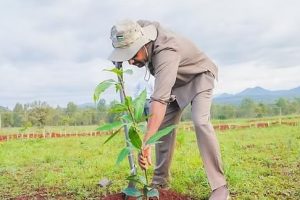
On 25th of March 2022, Prime Minister Abiy Ahmed (PhD) announced that preparations for the fourth year green legacy initiative are currently underway across the country. Seedling and land preparation and selection of places for the plantation are among the preparations currently underway for the coming plantation season.
In 2019, Ethiopia launched a national green legacy initiative to plant 20 billion seedlings within four years period. The national green legacy campaign of Ethiopia is part of its target goal of increasing its forest coverage to 30 percent within 10 years.
During the past three consecutive plantation seasons, Ethiopia planted over 17 billion trees across the country by mobilizing tens of millions of peoples. From the planted seedlings during the past three consecutive years, the average growing percentage is 80 percent.
Now, seedling plantation is becoming a national culture during the rainy season following the attention given by the government to combat climate change and its impacts. The first round of the four years’ Green Legacy Initiative of Ethiopia will be completed during the coming plantation season by planting over five billion seedlings throughout the country. For the fourth year seedling plantation period, preparations are underway according to Ministry of Agriculture.
Speaking to Ethiopian Press Agency (EPA) last week, Minister of Agriculture Umer Hussen said that preparations are underway for the upcoming fourth year green legacy initiative. He stated that preparation for the fourth year plantation season was started immediately after the completion of the third year plantation season and currently over 6.7 billion seedlings are on preparation across the country to be ready for the fourth year green legacy campaign.
Nursery preparations were finalized early following the process of preparing seedlings. “Though the plan is to plant five billion seedlings during the fourth year plantation season, considering the perishable seedlings during preparation and plantation, the preparation includes surplus seedlings and over 6.7 billion seedlings are on preparation,” Umer said.
According to the Minister 40 to 50 percent of the 6.7 billion seedlings preparing for the upcoming plantation season are plants for food security purpose like mango, papaya, banana, coffee and other fruits and vegetables. Umer noted that the seedlings planting for food security purpose are plants which take four to five years period to start production. This initiative of forest sector development gives due attention to realize the country’s journey of securing food self-sufficiency parallel to increasing the forest coverage of the country.
Umer reiterated that from the seedlings planted in 2021 summer, third edition of the green legacy initiative, over 80 percent of the seedlings have sprouted growing according to the first round survey assessment. He underlined that second round survey is also underway to identify the growing degree of the past year’s planted seedlings.
According to Umer, the first and second round growing degrees of the planted seedlings were better than the third round. According to him, different reasons like drought in some parts of the country and other local factors, affected the growing of the third round planted seedlings, he added.
“Prime Minister Abiy Ahmed started the green legacy initiative to plant 20 billion trees within four year period,” Umer said adding that “the first round of the four year initiative period will finalize during the upcoming rainy season.” “During the three years’ green legacy initiative, over 17 billion seedlings were planted across the country” The minister stated with a confidence to pass the target of 20 billion seedlings after the fourth year plantation.
After the fourth year plantation of the first round, the second cycle of green legacy initiative will be continued according to the Minister. For him, during the second cycle of green legacy initiative, by focusing on quality, the focus would be on planting and developing plants for food security considering the import substitution of food items by local products. The forest sector would play its role in this regard.
The minister also noted that Ethiopia’s target is to expand the national green legacy initiative to the region by distributing seedlings to its neighbors. So far, prepared seedlings were sent to Djibouti and planted there. Similarly seedlings were sent to other neighboring countries via air and land transportation. Ethiopia’s initiative to struggle the global warming will be strengthened and the country will continue to distribute seedlings to its neighbors, he said. According to Umer, plantation of the fourth year’s green legacy initiative will be launched immediately after a rainfall of the rainy season started.
In addition to focusing on increasing forest coverage through mass plantation of new seedlings, Ethiopia gives due attention to environmental protection, land rehabilitation and conservation efforts by mobilizing its people during January and February months. The environmental protection and rehabilitation initiative of Ethiopia aims to rehabilitate affected areas, protecting basins and recovery of damaged ecologies through different protection mechanisms.
Preparing selected places for the plantation season is part of the two months environmental protection, rehabilitation and recovery efforts. Parallel to building terraces, leveling mountainous areas to protect from soil erosion and other protection activities, well drilling for the next plantation is one part of the two months free service environmental protection.
During the fourth year green legacy plantation year, in addition to plants for food security, it gives due emphasis to indigenous trees. Taking lessons from every year’s achievements and performances of the plantation, huge amount of indigenous tree seedlings are readied for the fourth year plantation period.
Due attention is given for the preparation of indigenous tree species at the nurseries with the focus of making indigenous trees dominant during the fourth year green legacy campaign.
Meanwhile, Gulele Botanical Garden is preparing over one million indigenous tree species seedlings to be planted during the upcoming plantation period. Horticulture Development Director with the center, Mekbib Mamo told ENA that preparation of seedlings for the upcoming plantation period is underway.
According to Mekbib, the garden plans to prepare over one million indigenous tree species seedlings for the upcoming plantation season to support the country’s plantation initiative. So far, over 600 thousand indigenous tree seedlings of 120 types of indigenous tree species are already prepared, he added. Efforts are continued to prepare the remained planned seedlings to prepare within the coming months.
Mekbib underlined that all the million seedlings to be prepared by the center are indigenous tree species. For him, these tree species are resilient to weather conditions, suitable with the local atmosphere and have high capacity of ecological conservation benefits.
According to him, indigenous trees are long-lived, resilient and ecologically suitable trees and focusing on indigenous trees during the plantation campaign brings more positive change in increasing the growing degree of the planting trees and increasing the forest coverage of the country.
BY DARGIE KAHSAY
THE ETHIOPIAN HERALD TUESDAY 5 APRIL 2022





